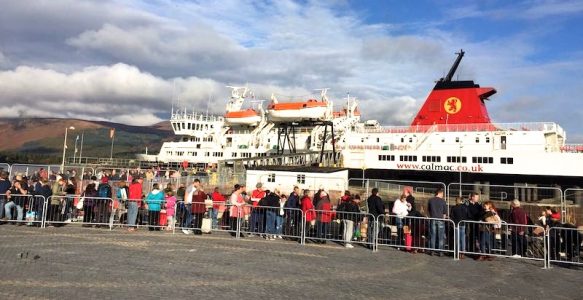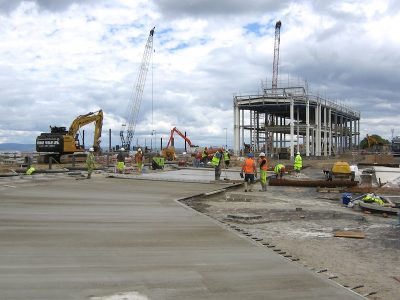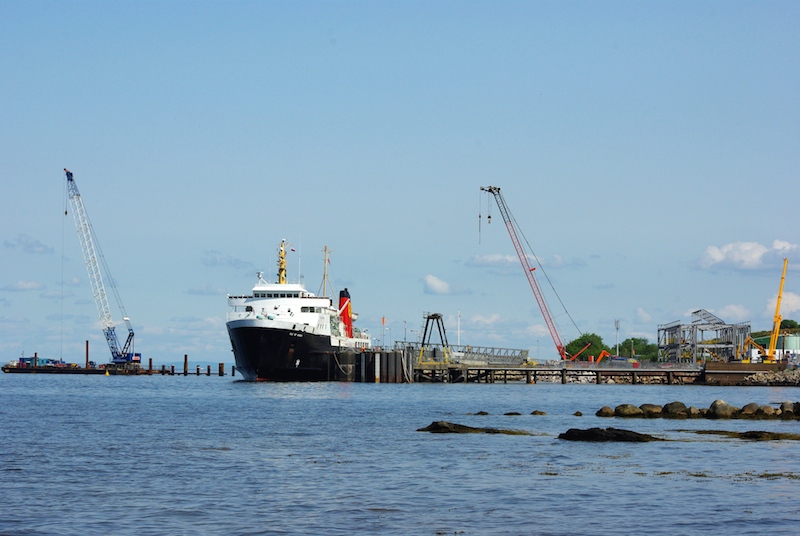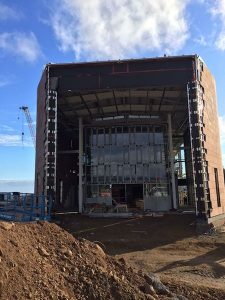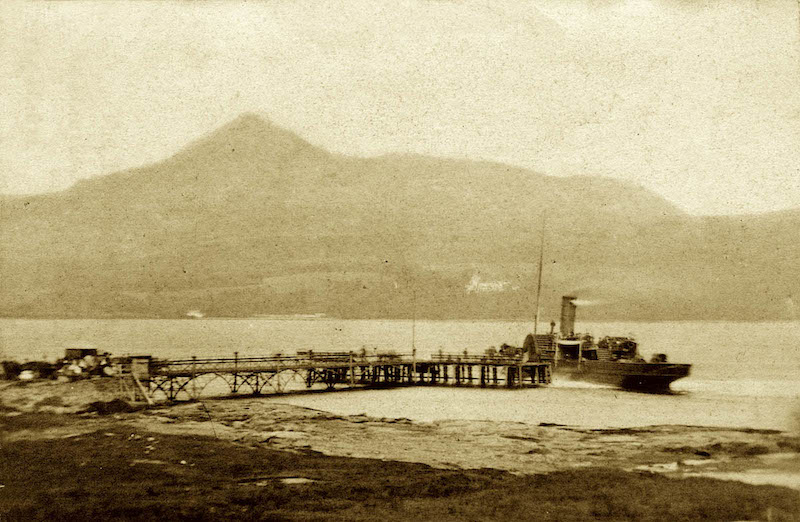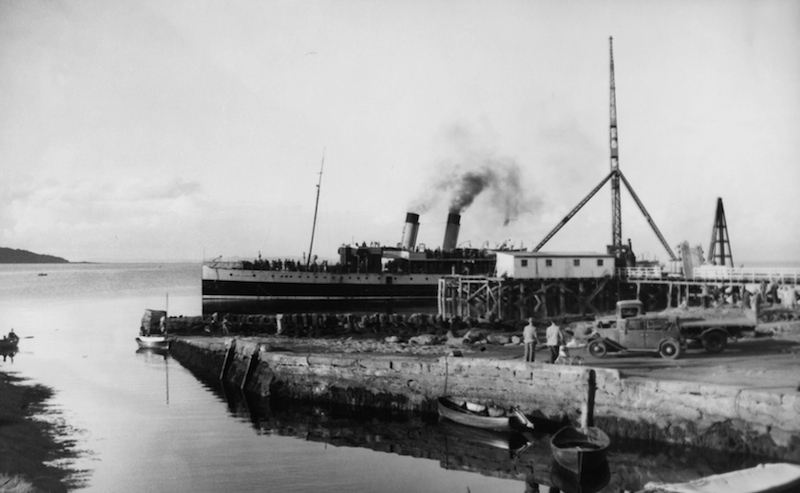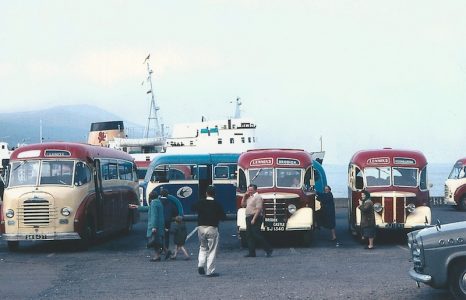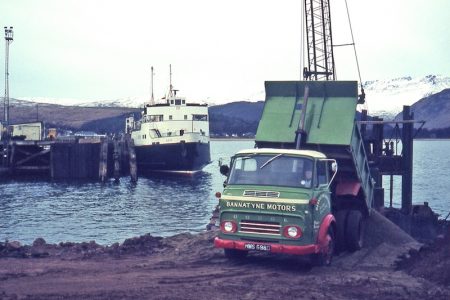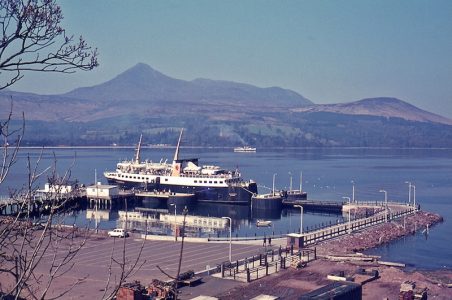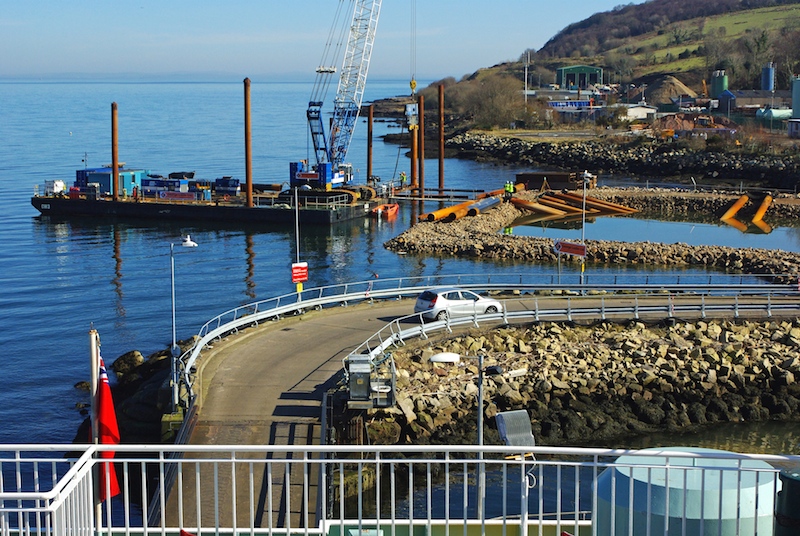 Eric Schofield, experienced observer of the Arran scene, sees the construction of Brodick’s new ferry terminal as a significant step in the evolution of transport links with the island.
Eric Schofield, experienced observer of the Arran scene, sees the construction of Brodick’s new ferry terminal as a significant step in the evolution of transport links with the island.
First time visitors to Arran this year must have wondered if they had made the right choice of holiday destination as they landed at Brodick. Instead of arriving at a peaceful, laid-back island resort they came ashore direct into a chaotic-looking building site, replete with yards and yards of ‘Heras’ fencing. Fears of a Spanish Costa-style development must have sprung to mind. This was, however, just the inevitable sufferance that the new Brodick Harbour construction would entail.
The seed for modernisation was planted on 1 August 1969, when the Scottish Transport Group (through its wholly owned subsidiary, the Caledonian Steam Packet Company) acquired Arran Piers Limited. In the early days of steamboat operations Lamlash had been the most favoured point of contact with the mainland due to its sheltered bay, but it was at Brodick, next to the Strathwhillan Burn, that Arran’s first steamer pier came into being in 1872. This wrought iron structure was replaced by a wooden pier early in the 20th century, later strengthened after the Second World War.
Later again, a dolphin was erected to assist berthing, thereby facilitating the introduction in the 1950s of proper car ferrying services — a step many on the island viewed with some trepidation. Regular holidaymakers from Glasgow and other mainland towns, accustomed to meandering along Arran’s roads, quickly learnt that road sense was no longer something that could be left at home during their annual summer visits. At the end of June 1957, Arran’s first dedicated car ferry, Glen Sannox, took up station, with Fairlie and Ardrossan as alternate mainland destinations.
On acquisition of the pier in 1969 the STG was able to make progress on its plan to introduce drive on/off facilities, replacing the cumbersome lift on/off method of vehicle handling, and by mid May 1970 Glen Sannox, now fitted with a stern ramp, was loading and unloading cars via a linkspan. On May 29 that year she handed over the route to Caledonia (the former Swedish ferry Stena Baltica) — a newcomer with bow and stern doors, giving Arran a true drive-through service, with sailings now exclusively to and from Ardrossan, which had also received a linkspan. Since then traffic has developed at a steady rate, with larger vessels, an increased number of crossings and, from 2005, provision of a back-up ferry during the summer months.
As vessel size increased, so did the age-old problem of berthing in adverse weather conditions — and with the current incumbents, Caledonian Isles and Isle of Arran, now respectively 23 and 32 years old, demand for a more dependable link with the mainland has prompted further development, one which will bring about the demise of the 1872 pier. Brodick’s new harbour is scheduled for completion at some point in 2017. A new 100-metre ferry for the Arran run is under construction at Port Glasgow. All recent developments have been overseen by Caledonian Maritime Assets Limited, a Scottish government-controlled entity which, since 2006, has been legal owner of the ferries and harbours operated by CalMac Ferries Ltd.
The new harbour development, on the eastern (seaward) side of the causeway leading to the current linkspan, comprises a two-berth pier set at almost a right angle to the shoreline. It will have a handsome two-storey building with reception/waiting room and associated facilities, and a high-level walkway to the gangways. Other new features include a larger, improved vehicle marshalling area, a more spacious bus stance area and separate car parking area.
The earliest sign that change was underway came in July 2014 when a small drilling rig was spotted offshore to carry out test borings. Construction work commenced on 11 January 2016. The first phase involved preparation of the ground, working out from the shore where the new terminal building and pier will be positioned and in the lagoon between the old pier and the current linkspan access road — this to become part of the new vehicle marshalling area.
Pile driving began in March and by springtime a temporary access route for cars to and from the ferry was in operation, winding round the west side of the new terminal block from a temporary car marshalling area. It was around this time that Burhou 1, Scotglen Shipping’s modern-day ‘puffer’, as they like to call it, was chartered for some weeks to bring rock from Loch Fyneside quarries. Large prefabricated concrete sections were shipped over from the mainland.
Following installation of these underpinnings, the infill and resurfacing of land incorporating the new bus stances and the area leading to the new terminal building duly followed in June/July. Interestingly, when I sailed over on Isle of Arran on May 24, her bow ramp was out of commission, so stern loading at both piers was the order of the day, and the articulated lorries bringing these sections had the tricky task of reversing on to the ferry at Ardrossan.
Into August and the new bus stances were brought into use, thus allowing work to commence on creating a new road through the old bus stance area, then round the seaward side of the current terminal building and leading to the new vehicle marshalling area. Meantime construction of the terminal building was proceeding apace, attracting comments such as “impressive”, “incongruous” and “unnecessarily expensive” from some of the travelling public. By mid September the terminal, with its proofing membrane fitted, looked for all the world like a massive new ferry hull awaiting installation of the bow door section.
By this time the new pier was beginning to take shape, with support structures for the linkspan in evidence, and by early October vehicles were being marshalled facing east, the temporary access route to the current linkspan now snaking its way east of the new terminal and along its seaward side.
About the same time the access road round the existing terminal building was beginning to take shape. Careful project planning and well-synchronised control of resources have ensured steady progress, so that hundreds, nay thousands, of vehicles and foot passengers have been able to move to and from the ferries with minimal disruption, especially through a remarkably busy summer period.
As work progresses, I cannot help thinking that ferry photograph opportunities might be somewhat limited once the new pier is fully operational, a problem that will not be unique to Brodick. But this shouldn’t deter enthusiasts from adding a new batch of photographs to their collections. The accompanying pictures give some indication of progress so far. Come to CRSC’s December meeting and get the full picture, when CMAL executives reveal their plans and enlighten us on the latest work at Brodick.
At Jurys Inn, Glasgow, on December 14, CMAL’s John Salton and Ramsay Muirhead will outline the strategy behind this and other west coast harbour developments, and offer a progress report on MV Catriona. A CMAL video of the Brodick Harbour development project can be viewed here.
Eric Schofield is CRSC’s Honorary Secretary.
BRODICK PIER IN FOCUS, PRESENT AND PAST
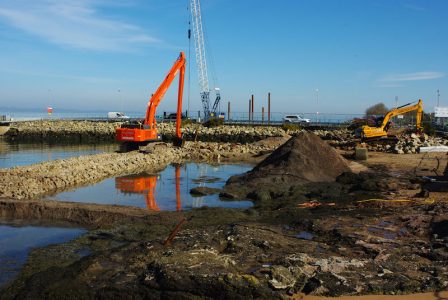
March 2016: work proceeds on reclaiming the lagoon inside the ‘old’ pier and linkspan — copyright photo Eric Schofield
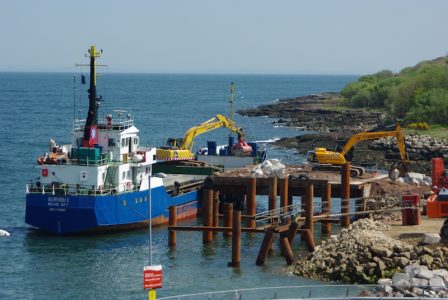
May 2016: Burhou 1 unloads boulders at the temporary pier next to the existing linkspan access road — copyright Eric Schofield
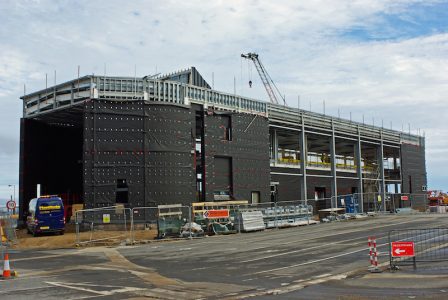
September 2016: the two-storey new terminal building takes shape, dominating the harbour landscape and attracting all sorts of comments from travellers — copyright photo Eric Schofield












